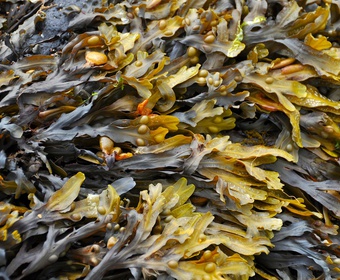
Brown algae
Brown seaweed keeps well and can be stored for up to three weeks in the fridge. Several varieties can be bought dried in Asian supermarkets, in well-stocked supermarkets or online but you might also find them on the beach. Dried brown algae can be used and eaten dry as they come, otherwise soak or simmer them in water before cooking them.
Estimate that dried algae will swell up to as much as ten times its weight.
Kelp/kombu
Kelp is a sturdy brown algae that grows in “forests” under the sea bed. The leaves are dark green and fleshy. Edible kelp often goes by the Japanese name kombu. It’s popular in the Chinese, Korean and especially Japanese cuisine.
Kombu is a common flavoring in the Japanese stock, dashi. Kelp contains a natural glutamic acid, an amino acid that is the source of what the Japanese call the fifth basic flavor, umami. This is why kelp is often used to flavor stock, gravy and stews. It also turns up as an ingredient in herb salt.
Kelp – like carrageen moss – is also used as a thickener in food, such as ice cream, jam and sauces. You have very probably eaten quite a lot of kelp under the name E400.
The kombu you find on the supermarket shelves is often dried and packaged.
How to cook kelp
Kelp is often sold dried under the name kombu. Simmer it in hot water for 10-15 minutes and it turns into a soft, appetizing ingredient.
The dried leaves make good “crisps” if you soak them first and then roast them in the oven. You can also add them to pesto for an extra deep flavor.
When braising and boiling, add a few pieces of kelp during the last stage just to draw out deeper flavors. In meat and fish dishes it will boost the umami flavor. Vegetarian dishes will be more filling with more of this fifth flavor.
Kelp can also be used to soften beans during cooking.
Wakame
Wakame is a medium-strength brown algae, although it looks green, which is often used in miso soup in sushi restaurants. It originally comes from Japan, is mild in flavor and goes well in a salad and with fish and meat. You can also fry threads of wakame to make an attractive and great-tasting garnish. The flavor of this algae is slightly sweet.
Hijiki
This is another brown algae that’s common in Japanese cuisine. It is used in soups and stews and can be recognized by the fact that it is black and looks a bit like tea leaves. It contains small amounts of arsenic and you shouldn’t eat vast quantities of it.
Bladderwrack
There are several species of bladderwrack. This seaweed gets its name from the “bladders” that sit in pairs on the green-brown stalks. The stalks are flat like leaves and have a central vein (unlike bushy, knotty knot kelp). The bladders make the “leaves” float up towards the sun.
Bladderwrack can be found in great quantities along the Atlantic coast. If you’re picking it to eat, make sure you take it from clean water, far from boats or polluted areas. Only pick the outermost, tender leaves, ideally early in the season. The tougher parts of the plant won’t be fun to deal with in the kitchen...
How to cook bladderwrack
This is a substantial seaweed that can be fried as decoration and as food on the plate. Smaller pieces – not unexpectedly – are more appetizing.
Add it to chunky stews. Some say that the seaweed itself is a delicacy.
If picking it yourself: No species of seaweed is poisonous but you might encounter species and algae (e.g. if they have grown too big) that don’t taste nice.
It’s said that bladderwrack tastes like rocket…
Knot kelp
Knot kelp is thicker and – believe it or not – knottier than bladderwrack. The stalks are knotty and have bladders practically everywhere (on bladderwrack the stalks are flat with a central vein and look like leaves).
How to cook knot kelp
Blanch it and serve with meat, as if it was cabbage or any another kind of vegetable.
You can also dry it and use it to flavor butter. Or just crumble over egg and fish.
Sea lace
This brown, thready algae looks roughly like strawberry laces, if you remember those sweets. The color isn’t very appealing but it’s mild and tastes good.
How to cook sea lace
Add it to pasta to fill it out and as a decoration. It doesn’t just taste good, it’s also nutritious and almost free of calories.
Dip bunches of sea lace in flour and deep fry for an attractive tangle to garnish fish dishes.


